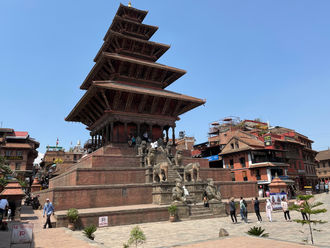
BHAKTAPUR DURBAR SQUARE
Once a fortified precinct, the Bhaktapur Durbar Square is a former palace complex much larger and grander than the other Durbar Squares of Nepal. Unlike Patan and Kathmandu, this public square lies on the outskirts of the city, away from the everyday bustle of the city. A UNESCO World Heritage Site, the Bhaktapur square was said to have 99 courtyards, of which only 15 remain. The former square housed the main palace, schools, government offices, and private residences, which were damaged due to the frequent earthquakes, mainly in 1833 and 1934. The spatial configuration of the square is defined by multiple small and big temples, shrines, palaces, and courtyards that create a play of open and built spaces throughout. The monuments here are more Hindu-oriented since Bhaktapur was described in legends as being planned in the shape of Shiva's damaru.
While the temples here display an intricate work of Newari craftsmanship, the Palace of 55 Windows is a masterpiece of wood carvings that dates back to the 15th century. Built in the year 1697 by King Bhupatindra Malla, it features ornately carved windows and a magnificent golden gate (Sun Dhoka), a metal entrance gate adorned with sculptures of Hindu deities. The statue of King Bhupatindra Malla on the top of the pillar, in front of the Golden Gate is said to have been installed by his son Ranjit Malla, which is also a work of intricate artistry of the Newari craftsmen.
Another iconic structure is the Vatsala Temple and the Taleju Bell, known for its sandstone architecture and a massive bell, often called the "Bell of Barking Dogs." The Nyatapola Temple, a five-story pagoda and the tallest temple in Nepal was built in 1702 and is an excellent example of Newari architecture that has withstood many earthquakes due to its solid foundations and design. In the 15th century, King Yaksha Malla created a group of temples that were a terracotta replica of the Char Dham of India. The four temples that were built here, similar to their names in India are the Kedarnath and Badrinath of Uttarakhand, Ramanathaswamy Temple of Rameshwaram, and the temple of Jagannath in Puri.
The temples and the monuments of the Bhaktapur Square exhibit the superiority of Hinduism and Buddhism through the Newari artistry and craftsmanship. However, there are subtle hints of Mughal influence too, that are seen here, reminding of Nepal’s historical role as a crossroads of trade and culture in South Asia. An example of this is the royal palace where a lattice window was installed by King Bhupatindra Malla which was gifted to him by a Mughal Emperor. The window was destroyed in the earthquakes, but it is still a part of the legends that showcase the expanse of the Malla Kings and their reign. Other elements like the latticework, metal inlays, and floral motifs, were also a huge part of the Newari woodwork and share similarities with these Mughal influences as well.
References:
-
Hutt, Michael. 2010. Nepal: A guide to art and architecture of Kathmandu valley.
-
“Bhaktapur Durbar Square: An Architectural Marvel in the Himalayas.” 2024. Amazing Nepal Adventure. March 5, 2024. Accessed December 3, 2024. https://amazingnepaladventure.com/2024/03/05/bhaktapur-durbar-square/
-
Dhwty, and Dhwty. 2020. “Nepal’s Bhaktapur Durbar Square: Heart of an Historic Capital.” Ancient Origins Reconstructing the Story of Humanity’s Past. August 18, 2020. https://www.ancient-origins.net/ancient-places-asia/bhaktapur-durbar-square-0014137

Statue of King Bhupatindra Malla with the Vatsala Temple in the backdrop
(Source: Rupali Gupte)

The Golden Gate (Sun Dhoka)
(Source: Rupali Gupte)

Intricate carvings of various Hindu Deities can be seen all over the structures in the Durbar Square
(Source: Rupali Gupte)
-
Sethi, Ankit. 2024. “Bhaktapur Durbar Square | History, Old Temples, Palaces, Timings!” Mysterioustrip. August 16, 2024. https://mysterioustrip.com/bhaktapur-durbar-square/
-
Pathfinder. 2024. “Bhaktapur Durbar Square: A Glimpse Into Nepal’s Rich Heritage.” Browse Nepal. September 30, 2024.
-
https://browsenepal.com/bhaktapur-durbar-square-a-glimpse-into-nepals-rich-heritage/
DRAWINGS




